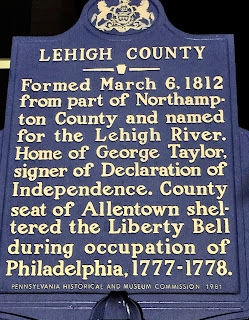I hope that all of my readers are safe and well during this unprecedented situation with COVID-19. My heart goes out to everyone who has been affected.
Before we get into today's quest, I wanted to share the announcement of the 2020 historical marker selections. Of course, circumstances being what they are right now, it's hard to say when the dedication ceremonies for any of these will be taking place, but I'm looking forward to a time when that becomes possible again. I'm especially excited that the Liberty Bell Museum in Allentown will be receiving a marker, since I had been surprised to find that they didn't already have one, and I will definitely be attending that ceremony whenever it gets scheduled. And my thanks to Karen Galle for promoting this blog in the article!
Moving on to the main event here, I was looking through my remaining saved markers - I have enough material to take us through June, at least, thankfully. For today's post, I thought we might wander around the county of my own birth.
 |
| The marker is located at 503 West Hamilton Street, Allentown, in front of the Old Courthouse |
What is today Lehigh County was originally part of Northampton County. Originally home to the Lenni Lenape tribe of Native Americans, Europeans began to settle in order to trade with them in the early 1700s. In or about 1730, the first German settlers were drawn to the region by William Penn's favorable reports, which by definition means their descendants are the Pennsylvania Dutch. (To be Pennsylvania Dutch, your ancestors had to have come here before 1800. If they came in or after 1800, you're Pennsylvania German. It's an odd distinction.) The area didn't actually become Lehigh County until 1812, when Northampton County - which had itself originally been part of Bucks County - was subdivided. The newly formed county was named after the Lehigh River, a tributary of the much larger Delaware River, which forms part of the border between Lehigh and Northampton Counties. The county seat is Allentown - yes, the one from the Billy Joel song - which is the third-largest city in the commonwealth. No prizes for naming the two larger ones.
I think people are sometimes confused as to the difference between Lehigh County and the Lehigh Valley. They aren't quite the same thing; the Valley, as the name implies, was carved by the river. Lehigh County is a big chunk of the Lehigh Valley, but the Valley also includes Northampton and Carbon Counties. It's a historically significant area, having made large contributions to the steel and coal industries.
 |
| Lorikeets at the Lehigh Valley Zoo, who clearly didn't find me nearly as interesting as the people holding treats |
Sports fan? Lehigh County has you covered. The IronPigs are a local AAA affiliate of the Philadelphia Phillies, while the Lehigh Valley Phantoms play minor league hockey at the PPL Center. Or check out the action at the Valley Preferred Cycling Center, the most prestigious cycling arena in the United States. Lehigh County has produced a number of famous athletes, like football player Andre Reed, baseball player Curt Simmons, and Olympic medalist Marty Nothstein.
For days when you need to find an indoor activity, there are still plenty of options. The Allentown Art Museum, which is the major hub of the ArtsWalk community, was opened in 1934 by the Pennsylvania impressionist Walter Emerson Baum. It boasts a collection of more than 19,000 works of art, including an authentic Rembrandt and an entire room designed by Pennsylvania architect Frank Lloyd Wright. Shoppers once frequented Hamilton Mall, which is a portion of Hamilton Street in Allentown, which included the world-famous Hess's Department Store; nowadays it's more common to visit Whitehall's Lehigh Valley Mall. It's the largest shopping mall in the region, quite possibly the largest one north of the King of Prussia Mall near Philadelphia, and is home to more than 140 stores. The Dave and Busters chain will be opening its newest location on the mall property later this spring.
 |
| Close up of the surviving Saylor kilns in Coplay |
It's hard for me to know what to say about Lehigh County, to be honest, because I've never tried to describe it. It's home. I wish I could know what Philip Kratzer, my first European ancestor to arrive in the New World, was thinking when he came here from Germany. What did he see, 300 years ago, and could he have imagined how much would change? Could anyone?
Sources and Further Reading:
Official website of Lehigh County
Lehigh County Historical Society
Butterbaugh, Kelly Ann. Lehigh County (Then and Now). Arcadia Publishing, 2011.
Assorted authors. History of Lehigh County, Pennsylvania. Lehigh Valley Publishing Co., 1914. Available courtesy of the Internet Archive.
Whelan, Frank. "What the heck's a Lehigh?" WFMZ 69 News. Originally produced June 10, 2011; last updated October 10, 2019.
LehighValleyHistory.com
Lehigh County at the Historical Marker Database
Except where indicated, all writing and photography on this blog is the intellectual property of Laura Klotz. This blog is written with permission of the Pennsylvania Historical and Museum Commission. I am not employed by the PHMC. All rights reserved.
Lehigh County Historical Society
Butterbaugh, Kelly Ann. Lehigh County (Then and Now). Arcadia Publishing, 2011.
Assorted authors. History of Lehigh County, Pennsylvania. Lehigh Valley Publishing Co., 1914. Available courtesy of the Internet Archive.
Whelan, Frank. "What the heck's a Lehigh?" WFMZ 69 News. Originally produced June 10, 2011; last updated October 10, 2019.
LehighValleyHistory.com
Lehigh County at the Historical Marker Database
If you've enjoyed this, please leave a comment!
Except where indicated, all writing and photography on this blog is the intellectual property of Laura Klotz. This blog is written with permission of the Pennsylvania Historical and Museum Commission. I am not employed by the PHMC. All rights reserved.


No comments:
Post a Comment
I would love to hear from you!